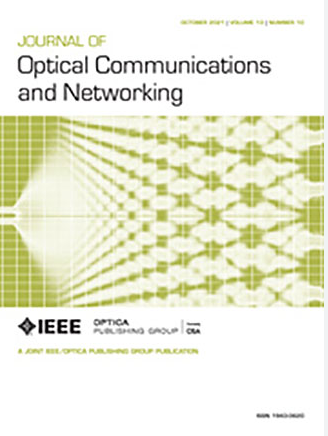面向 100G-PON 的低复杂度端到端深度学习框架
IF 4
2区 计算机科学
Q1 COMPUTER SCIENCE, HARDWARE & ARCHITECTURE
引用次数: 0
摘要
与传统的顺时针结构设计相比,端到端学习可使通信系统达到最佳性能。通过神经网络对信道进行建模,并在此可微分信道上对发射机和接收机进行训练,可以共同优化整个系统。然而,在现有方案中,生成式对抗网络和长短期记忆网络等信道建模方法架构复杂,无法跟踪信道变化,导致端到端学习效果不佳。同时,部署在发射器和接收器上的神经网络的复杂性太高,不适合实际应用。在这项工作中,我们提出了一种高效、低复杂度的端到端深度学习框架,并在 100G 无源光网络上进行了实验验证。它使用噪声适应网络对信道响应和噪声分布进行建模,并采用离线预训练和在线跟踪训练来提高信道建模的效率和准确性。对于发射器,它由一个基于神经网络(NN-PDLUT)的模式依赖查找表(PDLUT)和一个卷积层组成。此外,接收器也是一个具有单卷积层的神经网络;因此,端到端信号处理非常简单。实验结果表明,与基于 Volterra 非线性均衡 (VNLE) 的纯接收器均衡以及基于 PDLUT 和前馈均衡器的联合均衡相比,端到端学习可将接收器灵敏度分别提高 0.85 和 1.59 dB。此外,与基于 Volra 非线性均衡 (VNLE) 的纯接收器均衡相比,端到端学习方案中发射器和接收器消耗的乘法累加运算次数减少了 75.7%。本文章由计算机程序翻译,如有差异,请以英文原文为准。
Low-complexity end-to-end deep learning framework for 100G-PON
End-to-end learning allows communication systems to achieve optimal performance compared with conventional blockwise structure design. By modeling the channel with neural networks and training the transmitter and receiver on this differentiable channel, the whole system can be jointly optimized. However, in existing schemes, channel modeling methods, such as the generative adversarial network and long short-term memory network, have complex architectures and cannot track channel changes, leading to less effective end-to-end learning. Meanwhile, the complexity of neural networks deployed at the transmitter and receiver is too high for practical applications. In this work, we propose an efficient and low-complexity end-to-end deep learning framework and experimentally validate it on a 100G passive optical network. It uses a noise adaptation network to model channel response and noise distribution and employs offline pretraining and online tracking training to improve the efficiency and accuracy of channel modeling. For the transmitter, it consists of a pattern-dependent look-up table (PDLUT) based on a neural network (NN-PDLUT) with a single convolutional layer. Further, the receiver is also an NN with a single convolutional layer; thus, the end-to-end signal processing is extremely simple. The experimental results show that end-to-end learning improves the receiver sensitivity by 0.85 and 1.59 dB compared with receiver-only equalization based on Volterra nonlinear equalization (VNLE) and joint equalization based on a PDLUT and a feed-forward equalizer, respectively. Moreover, the number of multiply–accumulate operations consumed by the transmitter and receiver in the end-to-end learning scheme is reduced by 75.7% compared with VNLE-based receiver-only equalization.
求助全文
通过发布文献求助,成功后即可免费获取论文全文。
去求助
来源期刊
CiteScore
9.40
自引率
16.00%
发文量
104
审稿时长
4 months
期刊介绍:
The scope of the Journal includes advances in the state-of-the-art of optical networking science, technology, and engineering. Both theoretical contributions (including new techniques, concepts, analyses, and economic studies) and practical contributions (including optical networking experiments, prototypes, and new applications) are encouraged. Subareas of interest include the architecture and design of optical networks, optical network survivability and security, software-defined optical networking, elastic optical networks, data and control plane advances, network management related innovation, and optical access networks. Enabling technologies and their applications are suitable topics only if the results are shown to directly impact optical networking beyond simple point-to-point networks.

 求助内容:
求助内容: 应助结果提醒方式:
应助结果提醒方式:


